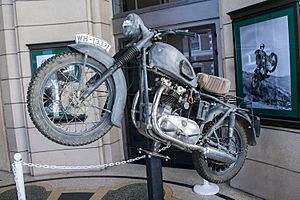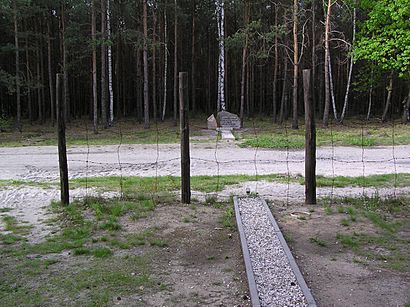The Great Escape (film) facts for kids
Quick facts for kids The Great Escape |
|
|---|---|
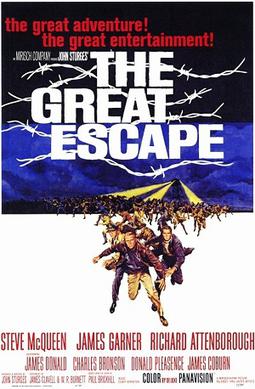
Theatrical release poster by Frank McCarthy
|
|
| Directed by | John Sturges |
| Produced by | John Sturges |
| Screenplay by |
|
| Starring | |
| Music by | Elmer Bernstein |
| Cinematography | Daniel L. Fapp |
| Editing by | Ferris Webster |
| Studio | The Mirisch Company |
| Distributed by | United Artists |
| Release date(s) | June 20, 1963 (London) July 4, 1963 (United States) |
| Running time | 172 minutes |
| Country | United States |
| Language |
|
| Budget | $3.8 million |
| Money made | $11.7 million |
The Great Escape is a famous 1963 American adventure war film. It stars Steve McQueen, James Garner, and Richard Attenborough. The movie was filmed using a special camera system called Panavision. Its exciting music was created by Elmer Bernstein.
The film is based on a true story from Paul Brickhill's 1950 book, also called The Great Escape. It shows a made-up version of a huge escape. This escape happened during Second World War at a German prison camp called Stalag Luft III. Many British Commonwealth prisoners of war (POWs) tried to break free. The movie changed some details to make it more exciting and appeal to a wider audience. For example, it showed more American involvement than there was in real life.
The Great Escape was made by The Mirisch Company and released by United Artists. John Sturges produced and directed it. The film first showed in London on June 20, 1963. Critics loved The Great Escape, and it became one of the most successful movies that year. Steve McQueen even won an award for Best Actor at the Moscow International Film Festival. The movie is now seen as a classic. It's also famous for a thrilling motorcycle chase and jump scene. This scene is still considered one of the best stunts ever.
Contents
What is the movie about?
In 1942, during World War II, the German army moved Allied prisoners of war to a new camp. This camp was called Stalag Luft III. It was for prisoners who kept trying to escape from other camps. The camp's leader, Luftwaffe Colonel von Luger, warned the prisoners. He told them that anyone who tried to escape would be shot.
Even with this warning, many prisoners tried to get out right away. But none could get past the camp's fences. USAAF Captain Hilts, known for escaping many times, found a hidden spot. It was between two guard towers. He let himself get caught on purpose. This way, the guards wouldn't realize he found the spot. He was sent to solitary confinement, also called "the cooler." There, he became friends with RAF airman Ives.
Planning the Great Escape
RAF Squadron Leader Roger Bartlett started a secret group called "the X Organisation." This group planned the escape. The highest-ranking prisoner, British Group Captain Ramsey, quietly approved the plan. Bartlett believed that if 250 men escaped at once, it would help the Allied forces. The Germans would have to use many soldiers to find them, taking them away from the war front. The prisoners began digging three tunnels. They named them "Tom," "Dick," and "Harry."
Everyone helped with the plan. Hendley found important items on the black market. He became good friends with Blythe, who was an expert at making fake documents. Sedgwick made tools like picks and air pumps. Welinski and Dickes were in charge of the digging. MacDonald gathered information about the camp. Griffith sewed civilian clothes for disguises. Ashley-Pitt found a way to hide the dirt they dug from the tunnels. A choir, led by Cavendish, sang loudly to cover the digging noises. Cavendish also checked the tunnel routes.
Bartlett asked Hilts to help with the escape. He wanted Hilts to escape, scout the area, and then let himself be caught. This way, he could draw maps for the main breakout. Hilts first refused because he was too proud.
Challenges and Discoveries
Tunnel "Tom" was almost finished first. Bartlett ordered "Dick" and "Harry" to be closed off for a while. Hilts, Hendley, and Goff made homemade alcohol from potatoes. They celebrated the Fourth of July with everyone in the camp. But guards heard the celebration and found "Tom." Ives, feeling very sad, suddenly climbed the barbed wire fence and was shot dead. Hilts, shocked by this, then agreed to help Bartlett.
The prisoners then focused on tunnel "Harry." When part of the tunnel collapsed, Welinski had a panic attack. He told Dickes he was afraid of small, enclosed spaces (claustrophobic). He tried to break out through the fence, but Dickes calmed him down before he could be shot like Ives. Blythe found out he was losing his eyesight because of a condition called myopia. Hendley promised to be Blythe's eyes during the escape.
The Escape Attempt
The last part of "Harry" was finished. But when they broke through the surface, the tunnel was 20 feet short of the trees. This meant they were still visible to the guards. Hilts guided them with a rope signal. A sudden air raid blackout helped many prisoners escape. But then Cavendish slipped and made a noise. An impatient Griffith came out while a guard was checking. Griffith was captured, and the escape ended.
Seventy-six prisoners escaped and tried to flee across Europe. Only three made it to freedom. Welinski and Dickes rowed to a port and got on a ship to Sweden. Sedgwick reached France, where the Resistance helped him get to Spain.
The others were not so lucky. Cavendish got a ride on a truck, but the driver turned him in. Hilts stole a motorcycle and headed for the German-Swiss border. Soldiers chased him, his bike was shot, and he was caught again. Hendley and Blythe stole a plane to fly to Switzerland. But the engine failed, and they crashed. Blythe was shot, and Hendley was captured.
At a train station, a German officer named Kuhn, who was from the camp, was looking for escapees. Ashley-Pitt killed Kuhn to stop him from recognizing Bartlett. Ashley-Pitt was then shot and killed. Bartlett and MacDonald were still caught when another German officer tricked MacDonald into speaking English.
Most of the captured men were put into trucks. But instead of going back to the camp, they were taken to a field. There, 50 of them were killed by German authorities. This happened on Hitler's direct orders. Colonel von Luger, the camp commandant, was ashamed. He told Ramsey that 50 men were killed. A sad Hendley asked Ramsey if the escape was worth it. Von Luger was removed from his command. Hilts was sent back to the cooler, where he immediately started planning his next escape.
Who are the main characters?
- Steve McQueen as Captain Virgil Hilts ('The Cooler King'): An American prisoner who loves to escape and has a rebellious attitude.
- James Garner as Flight Lieutenant Bob Hendley ('The Scrounger'): An American officer who finds supplies for the escape. He becomes close friends with Blythe.
- Richard Attenborough as Squadron Leader Roger Bartlett ('Big X'): A British officer and the leader of the escape committee.
- James Donald as Group Captain Ramsey ('The SBO'): The highest-ranking British officer in the camp. He acts as the leader for the prisoners.
- Charles Bronson as Flight Lieutenant Danny Welinski ('Tunnel King'): A Polish officer who has dug many tunnels. He is very afraid of small spaces.
- Donald Pleasence as Flight Lieutenant Colin Blythe ('The Forger'): A quiet English officer who makes fake documents. He becomes good friends with Hendley.
- James Coburn as Flying Officer Sedgwick ('The Manufacturer'): An Australian officer who builds tools for the escape.
- Hannes Messemer as Oberst von Luger ('The Kommandant'): The German leader of the prison camp.
- David McCallum as Lieutenant-Commander Eric Ashley-Pitt ('Dispersal'): A British officer who figures out how to hide the tunnel dirt.
- Gordon Jackson as Flight Lieutenant Andy MacDonald ('Intelligence'): Bartlett's second-in-command, who gathers information.
- John Leyton as Flight Lieutenant Willie Dickes ('Tunnel King'): Welinski's best friend and a co-leader in tunnel building.
- Angus Lennie as Flying Officer Archie Ives ('The Mole'): An anxious Scottish airman who becomes friends with Hilts in the cooler.
How was the movie made?
Writing the Story
In 1963, the Mirisch brothers worked with United Artists to make a movie from Paul Brickhill's 1950 book, The Great Escape. Brickhill himself was a small part of the real escape team. The story had been shown on TV before, in 1951. The movie's script was written by James Clavell, W. R. Burnett, and Walter Newman.
Choosing the Actors
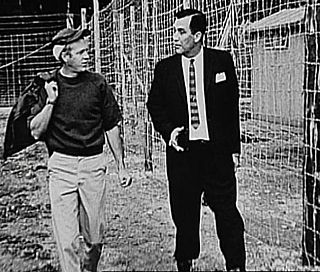
Many critics say Steve McQueen gave the best performance in the film. His role as Hilts helped him become a huge movie star. Hilts' character was based on a few real pilots.
Richard Attenborough played Roger Bartlett, "Big X." This character was based on Roger Bushell, the real mastermind of the Great Escape. This movie helped Attenborough become well-known in the United States.
Donald Pleasence, who played Colin Blythe ("The Forger"), had actually been a prisoner of war himself during World War II. He was shot down and spent a year in a German POW camp. Charles Bronson, who played Danny Welinski, also served in the war. Like his character, he suffered from claustrophobia (fear of small spaces) because he worked in a mine as a child.
Filming Locations
The movie was filmed in Germany, near the city of Munich. The film studio built sets for the barracks and tunnels. The prison camp itself was built in a forest clearing. Many scenes were also filmed in and around the town of Füssen in Bavaria. The famous Neuschwanstein Castle can be seen when Hendley and Blythe try to escape by plane.
The exciting motorcycle chase scenes were filmed in meadows outside Füssen. The "barbed wire" Hilts crashes into was made of rubber strips. This was to keep the actors safe. Steve McQueen was a skilled motorcyclist and did many of the stunts himself. However, the famous motorcycle jump over the fence was done by his friend, Bud Ekins. Ekins looked like McQueen from a distance. The motorcycle used was a Triumph TR6 Trophy, painted to look like a German bike.
How accurate is the movie?
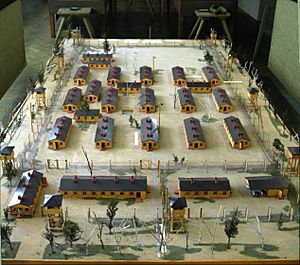
The movie changed many details to make the story more dramatic and exciting. For example, it showed more American prisoners involved in the escape. In reality, mostly British and other Allied prisoners were involved. A few American officers helped at first, but they were moved away before the actual escape. The film also doesn't mention how important Canadians were in building the tunnels. Wally Floody, a real-life "tunnel king" from Canada, even worked as an advisor for the film.
The film shows the tunnel "Tom" starting under a stove and "Harry" in a washroom drain. In real life, "Dick" started in the drain, "Harry" was under a stove, and "Tom" was in a dark corner.
The movie also doesn't show that some Germans actually helped the prisoners. Some German guards were against the Nazis and secretly gave the prisoners items and help. The film also shows the escape happening in good weather. But in reality, it was freezing cold and snowy.
In the movie, Hilts takes a motorcycle from a German soldier. Ashley-Pitt kills a German officer. Hendley knocks out a German guard. And Sedgwick sees French Resistance members kill German officers. In the real escape, no German personnel were killed or hurt by the prisoners.
In 2009, some of the real prisoners from Stalag Luft III returned for the 65th anniversary of the escape. They watched the film. They said that many parts of the first half of the movie, showing life in the camp and the tunnel digging, were very accurate. The film has helped keep the story of the 50 killed airmen alive for many years.
The Music of The Great Escape
The film's famous music was written by Elmer Bernstein. He gave each main character their own musical theme based on the main Great Escape tune. This music was so popular that Bernstein earned money from it for the rest of his life. Critics say the music is great because it uses exciting military sounds mixed with softer, warmer parts. This helps audiences connect with the prisoners. The main theme has become very popular in Britain, especially with sports fans.
More to Explore
- List of American films of 1963
- The Bridge on the River Kwai
See also
 In Spanish: The Great Escape para niños
In Spanish: The Great Escape para niños


